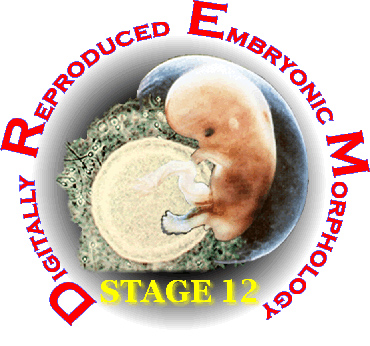Stage 12 embryos have a greatest length of 3 to 5.4 mm and an estimated postfertilization age of 29 to 31 days. There are 21 to 29 body segments (somites) along the body axis. In the older specimens the caudal neuropore is closed and secondary neurulation has begun. Most of the cephalic neural crests can be identified. The otic vesicle has formed but may remain connected to the overlying ectoderm. The sinu-atrial openings and atrioventricular canal are present in the heart. Tabeculation has begun in the ventricular walls. The aortic arches are present and the dorsal aortae are fused. Four pharyngeal arches, grooves and pouches are present. Future hepatic sinusoids are occupied by hematopoetic tissue and the mesonephric duct terminates caudally in the cloaca.
The stage is represented in the DREM databases by Carnegie embryo # 8943 that has a
grade of excellent. It
has a greatest length of 3.9 mm (after fixation) and an estimated postfertilization age of 29 days. There are 23 segments (somites) along the body axis which places it in the early part of stage
12.
The embryo
was prepared for microscopic examination in 1934 and was originally
part of the collection at the University of Chicago (No. H 1481).
The fixative for this specimen was Zenker's formol. It was embedded
in celloidin and paraffin and serially sectioned transverse to the
long axis at 8 microns. The sections were mounted on eight large glass
slides (click for images) and stained with
hematoxylin and eosin. There are 439 sections through the embryo.
There
is very little information available about this embryo. It has rarely
been the subject of studies or reconstructions.
The DREM
database includes 146 of the 439 sections. Approximately every third
section was digitally restored and labeled, and can be viewed at four
magnifications (only three zoom levels are available on the CD version).
Several 3D reconstructions were produced
from the aligned sections. Animations of the 3D reconstructions of
the embryo surface and the embryonic
heart together with a flythrough animation
of the aligned sections are also included on the disks. For anyone
who wishes to use them for other reconstructions, research or presentations,
all the original section images are available
as individual .jpg files. These files are zipped as an aligned
set of low resolution images, or as sets of the individual slides
captured at 20x.
Instructions
for using the disks can be found by going to the
Instructions section from the opening screen.


